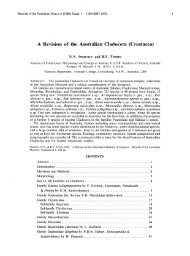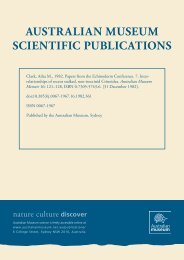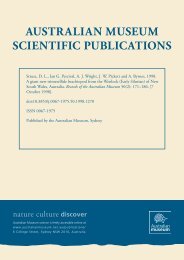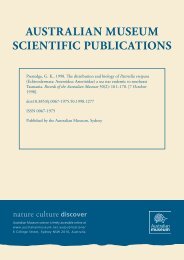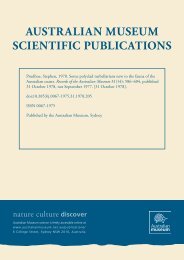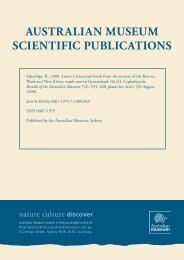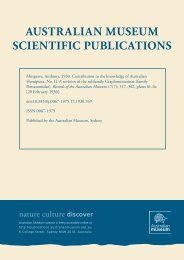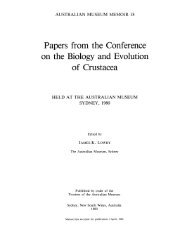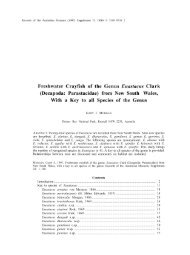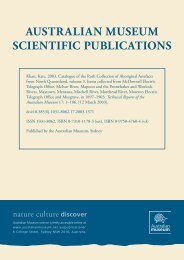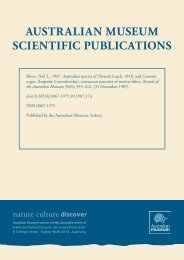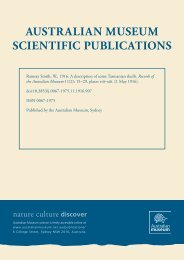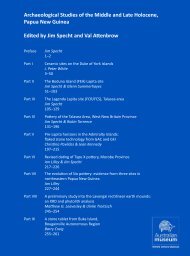Biogeographic and biostratigraphic implications of the - Australian ...
Biogeographic and biostratigraphic implications of the - Australian ...
Biogeographic and biostratigraphic implications of the - Australian ...
Create successful ePaper yourself
Turn your PDF publications into a flip-book with our unique Google optimized e-Paper software.
6 Records <strong>of</strong> <strong>the</strong> <strong>Australian</strong> Museum (2009) Vol. 61<br />
elegans Biozone) is characterized by abundant P. adami in<br />
association with Bergstroemognathus extensus, Drepanodus<br />
arcuatus, Paroistodus parallelus, P. proteus, Paracordylodus<br />
gracilis, Tropodus australis, Protop<strong>and</strong>erodus gradatus, <strong>and</strong><br />
Protoprioniodus simplicissimus, all <strong>of</strong> which are also present<br />
in <strong>the</strong> Emanuel Formation. According to Stouge & Bagnoli<br />
(1988, figs 3,4), both O. communis <strong>and</strong> P. elegans first appear<br />
at a similar level in <strong>the</strong> upper part (not top) <strong>of</strong> Bed 9 <strong>and</strong> define<br />
<strong>the</strong> boundary <strong>of</strong> <strong>the</strong> P. adami/P. elegans biozones in <strong>the</strong> upper<br />
part <strong>of</strong> Bed 9. Both P. proteus <strong>and</strong> P. parallelus make <strong>the</strong>ir first<br />
appearance near <strong>the</strong> base <strong>of</strong> Bed 9 <strong>of</strong> <strong>the</strong> Cow Head Group,<br />
about three m below <strong>the</strong> first appearance <strong>of</strong> P. adami.<br />
The first appearance (FAD) <strong>of</strong> Tetragraptus approximatus<br />
is <strong>the</strong> primary marker defining <strong>the</strong> base <strong>of</strong> <strong>the</strong> Floian Stage<br />
(Bergström et al., 2004). In <strong>the</strong> Diabasbrottet GSSP Section<br />
at Hunneberg, southwestern Sweden, <strong>the</strong> Tremadocian/<br />
Floian boundary was defined by <strong>the</strong> FAD <strong>of</strong> T. approximatus,<br />
2.1 m above <strong>the</strong> top <strong>of</strong> <strong>the</strong> Cambrian, <strong>and</strong> <strong>the</strong> lower part <strong>of</strong><br />
<strong>the</strong> T. approximatus graptolite Biozone was correlated to <strong>the</strong><br />
topmost subzone (Oel<strong>and</strong>odus alongatus-Acodus deltatus<br />
deltatus Subzone) <strong>of</strong> <strong>the</strong> P. proteus conodont Biozone (see<br />
Bergström et al., 2004, fig. 10). Therefore, <strong>the</strong> FAD <strong>of</strong> T.<br />
approximatus near <strong>the</strong> base (3m above <strong>the</strong> base at <strong>the</strong> Ledge<br />
Section) <strong>of</strong> Bed 9 in <strong>the</strong> Cow Head Group (Williams et al.,<br />
1999) suggests that <strong>the</strong> P. adami Biozone in Newfoundl<strong>and</strong><br />
should be correlated with <strong>the</strong> upper part <strong>of</strong> <strong>the</strong> P. proteus<br />
Biozone (Oel<strong>and</strong>odus alongatus-Acodus deltatus deltatus<br />
Subzone) <strong>of</strong> <strong>the</strong> Balto-Sc<strong>and</strong>ian succession.<br />
The P. adami-S. bilobatus Biozone is proposed herein<br />
to represent <strong>the</strong> fauna from <strong>the</strong> middle to upper part <strong>of</strong> <strong>the</strong><br />
Emanuel Formation. It is characterized by <strong>the</strong> occurrence <strong>of</strong><br />
P. adami, S. bilobatus, Paroistodus proteus, P. parallelus <strong>and</strong><br />
o<strong>the</strong>r species listed in Table 1, with its base defined by <strong>the</strong><br />
first appearance <strong>of</strong> S. bilobatus from <strong>the</strong> middle member <strong>of</strong><br />
<strong>the</strong> Emanuel Formation <strong>and</strong> <strong>the</strong> upper boundary defined by<br />
<strong>the</strong> first appearance <strong>of</strong> O. communis in <strong>the</strong> basal part <strong>of</strong> <strong>the</strong><br />
Gap Creek Formation (Nicoll & Ethington, 2004). It can be<br />
confidently correlated with <strong>the</strong> P. adami Biozone in <strong>the</strong> lower<br />
part <strong>of</strong> Bed 9 <strong>of</strong> <strong>the</strong> Cow Head Group in Newfoundl<strong>and</strong>, with<br />
<strong>the</strong> Oel<strong>and</strong>odus alongatus-Acodus deltatus deltatus Subzone<br />
<strong>of</strong> <strong>the</strong> P. proteus Biozone (possibly also lowest P. elegans<br />
Biozone) <strong>of</strong> <strong>the</strong> Balto-Sc<strong>and</strong>ian conodont succession, with <strong>the</strong><br />
S. diversus Biozone in <strong>the</strong> Honghuayuan Formation <strong>of</strong> South<br />
China, <strong>and</strong> with <strong>the</strong> S. bilobatus <strong>and</strong> S. extensus biozones in<br />
<strong>the</strong> Liangjiashan Formation <strong>of</strong> North China (Fig. 2).<br />
<strong>Biogeographic</strong> distribution <strong>of</strong> Serratognathus<br />
The morphologically distinctive conodont Serratognathus<br />
is widely distributed in Lower Ordovician (lower Floian)<br />
rocks in China (South China, North China Platform, Ordos<br />
Basin, Tarim Basin <strong>and</strong> sou<strong>the</strong>rn Hainan Isl<strong>and</strong>), Korea,<br />
Malaysia, <strong>and</strong> Australia (Arafura Basin <strong>and</strong> Canning<br />
Basin). Among <strong>the</strong> three species assigned to <strong>the</strong> genus (S.<br />
bilobatus Lee, 1970, S. diversus An, 1981, <strong>and</strong> S. extensus<br />
Yang in An et al., 1983), S. bilobatus has a relatively wider<br />
geographic distribution (Fig. 3) occurring in <strong>the</strong> Dumugol<br />
Formation <strong>of</strong> South Korea (Lee, 1970), in <strong>the</strong> Liangjiashan<br />
Formation <strong>of</strong> North China Platform (An et al., 1983), in <strong>the</strong><br />
Qianzhongliangzi Formation <strong>of</strong> <strong>the</strong> Ordos Basin in North<br />
China (An & Zheng, 1990), in <strong>the</strong> Honghuayuan Formation<br />
<strong>of</strong> South China (An et al., 1983; Ding et al. in Wang,<br />
1993), in <strong>the</strong> upper part <strong>of</strong> <strong>the</strong> Dakui Formation <strong>of</strong> Sanya,<br />
Hainan Isl<strong>and</strong> (Wang et al., 1996), in <strong>the</strong> lower part <strong>of</strong> <strong>the</strong><br />
Setul Limestone in Malaysia (Metcalfe, 1980, 2004), in <strong>the</strong><br />
Mooroongga Formation (subsurface) <strong>of</strong> <strong>the</strong> Arafura Basin<br />
<strong>of</strong>f <strong>the</strong> north coast <strong>of</strong> Australia (Nicoll unpublished material),<br />
<strong>and</strong> in <strong>the</strong> Emanuel Formation <strong>of</strong> <strong>the</strong> Canning Basin, Western<br />
Australia (this study). Zhylkaidarov (1998, p. 65) indicated<br />
<strong>the</strong> occurrence <strong>of</strong> S. bilobatus from <strong>the</strong> Shabakty Formation<br />
in Malyi Karatau <strong>of</strong> sou<strong>the</strong>rn Kazakhstan. However, as<br />
nei<strong>the</strong>r illustrations nor o<strong>the</strong>r information <strong>of</strong> <strong>the</strong> species<br />
from this locality are available, this Kazakhstan occurrence<br />
is considered doubtful at present. Serratognathus diversus<br />
is recorded in <strong>the</strong> Honghuayuan Formation <strong>and</strong> coeval units<br />
in South China (An et al., 1985; An, 1987; Zhen et al., in<br />
press a), Liangjiashan Formation <strong>of</strong> North China (An et al.,<br />
1983), <strong>and</strong> <strong>the</strong> upper subgroup <strong>of</strong> <strong>the</strong> Qiulitag Group <strong>of</strong> <strong>the</strong><br />
Tarim Basin (Zhao et al., 2000). Serratognathus extensus,<br />
possibly representing <strong>the</strong> most advanced <strong>of</strong> <strong>the</strong> three species,<br />
has been reported only from <strong>the</strong> Liangjiashan Formation <strong>of</strong><br />
North China Platform (An et al., 1983).<br />
The type material <strong>of</strong> S. bilobatus was described from <strong>the</strong><br />
Dumugol Formation in <strong>the</strong> Taebaeksan Basin in <strong>the</strong> centraleastern<br />
part <strong>of</strong> <strong>the</strong> Korean Peninsula (Lee, 1970; Choi et al.,<br />
2005). The Dumugol Formation (also called <strong>the</strong> Dumugol<br />
Shale) consists <strong>of</strong> shale <strong>and</strong> intercalated limestone whose<br />
thickness varies from 150 to 270 m across <strong>the</strong> region <strong>and</strong><br />
contains cyclic successions shifting from <strong>the</strong> near-shore to<br />
<strong>the</strong> deeper subtidal facies on a low-relief carbonate shelf,<br />
which was believed to be part <strong>of</strong> an extension <strong>of</strong> <strong>the</strong> North<br />
China Platform during <strong>the</strong> Early Ordovician (Choi et al.,<br />
2001, 2005). It yielded abundant conodont <strong>and</strong> trilobite faunas<br />
closely comparable to <strong>the</strong> late Tremadocian to early Floian<br />
faunas <strong>of</strong> North China (Lee, 1970, 1975; An et al., 1983;<br />
Zhou & Fortey, 1986; Seo et al., 1994; Choi et al., 2005).<br />
Occurrence <strong>of</strong> <strong>the</strong> Archaeoscyphia-Calathium association<br />
(occasionally forming isolated bioherms) in <strong>the</strong> Dumugol<br />
Formation also supports a close biogeographic link with<br />
North China (Choi et al., 2005). Based on rich <strong>and</strong> diverse<br />
conodont assemblages, Seo et al. (1994) divided <strong>the</strong> Dumugol<br />
Formation into four conodont biozones (in ascending order):<br />
Chosonodina herfurthi-Rossodus manitouensis Biozone,<br />
Colaptoconus quadraplicatus Biozone, Paracordylodus<br />
gracilis Biozone, <strong>and</strong> Triangulodus dumugolensis Biozone,<br />
with an age ranging from late Tremadocian to early Floian.<br />
They correlated <strong>the</strong> Triangulodus dumugolensis Biozone at<br />
<strong>the</strong> top <strong>of</strong> <strong>the</strong> Formation to <strong>the</strong> S. bilobatus Biozone <strong>of</strong> North<br />
China, but unfortunately S. bilobatus was not recovered from<br />
any <strong>of</strong> <strong>the</strong>ir studied samples, <strong>and</strong> <strong>the</strong> type horizon <strong>of</strong> this<br />
species described by Lee (1970) in <strong>the</strong> region was not pinned<br />
down in <strong>the</strong>ir new <strong>biostratigraphic</strong> scheme <strong>of</strong> <strong>the</strong> Dumugol<br />
Formation. However, Seo et al. (1994, p. 606) indicated that<br />
S. bilobatus also occurs in <strong>the</strong> overlying Maggol Formation<br />
as reported in two unpublished postgraduate <strong>the</strong>ses.<br />
In North China, S. bilobatus was widely reported as<br />
occurring in <strong>the</strong> Liangjiashan Formation within an interval<br />
correlated to <strong>the</strong> upper P. proteus Biozone to lower P.<br />
elegans Biozone <strong>of</strong> <strong>the</strong> Balto-Sc<strong>and</strong>ian conodont succession<br />
(Zhen et al., in press a). The Liangjiashan Formation is<br />
best exposed in <strong>the</strong> Zhaogezhuang Section near Tangshan,<br />
Hebei Province, where it consists <strong>of</strong> a 160 m sequence<br />
<strong>of</strong> a thick-bedded lower limestone member <strong>and</strong> an upper<br />
dolomite member (Chen Xu et al., 1995) that conformably<br />
overlies <strong>the</strong> Yeli (Yehli) Formation <strong>of</strong> Tremadocian<br />
age <strong>and</strong> is overlain by <strong>the</strong> Beianzhuang Formation <strong>of</strong> <strong>the</strong>




